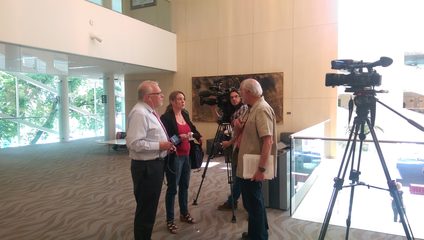
Written by Jaclyn Layton
With over 72 square kilometres of lush river valley, Edmonton presents a unique intersection of urban and green space. More expansive than Stanley Park of Vancouver (4 square kilometres), or even Central Park in New York City (3.4 square kilometres), Edmonton’s greenery is an aspect of the city that is celebrated, and therefore should be preserved and protected. The natural wonder of the North Saskatchewan River Valley has been at risk over the past 18 months over a proposed solar farm that would degrade the Valley’s natural state. EPCOR, the city’s water and wastewater utility provider, has proposed an expansion of their current operation near Terwillegar Park to encompass a power plant, providing green energy to their existing wastewater treatment facility. The plant would span 22 hectares, erecting 45,000 solar panels on EPCOR’s land adjacent to the E.L. Smith Water Treatment Facility. The power generated here would supply energy to the existing water treatment plant, and the remainder would be transmitted to the larger electrical grid. Sounds great, right? Here’s the catch, the land EPCOR proposes to develop is also directly adjacent to the North Saskatchewan River.
The conservation of the Edmonton River Valley has been a priority for the Sierra Club of Canada following the lead of policymakers, lawmakers, and citizens that came before us. The importance of this area was enshrined into law in 1985, in the North Saskatchewan River Valley Area Redevelopment Plan, also known as Bylaw 7188. The major goal of this plan is stated at the beginning of the document, that is, “[to] ensure the preservation of the natural character and environment of the North Saskatchewan River Valley and its Ravine System.” The Bylaw continues to call for stewardship of our River Valley, “in order to preserve sensitive or unique natural areas and to avoid the problems and costs associated with development in hazardous or sensitive areas”. Herein lies the core manifesto of the Bylaw - essentially asking the City of Edmonton, its developers, and its citizens to protect this important environment - and to only make concessions where there is absolutely no alternative.
Over the course of the week of June 17, 2019, Edmonton City Council heard over thirty presentations either in favour or in opposition to this project, with the key element of this decision boiling down to the necessity of this particular location. EPCOR justifies the degradation of our River Valley as the single cost-effective way to provide solar energy to their water treatment facility. According to the utility company, as this part of the valley is already owned by EPCOR, the acquisition of new lands would render this project infeasible. However, EPCOR representatives in attendance at city hall indicated that an alternative site could host the solar farm for less than 20 additional cents on a $50 monthly bill. Although it is difficult to place a value on such an important and biodiverse area, it’s easy to imagine that the preservation of our River Valley over the next three decades is worth much more than 20 cents a month.
Many other issues were raised in opposition to the industrialization of the Valley. Economic objections, as previously discussed, were accompanied by both environmental and social concerns. This is valuable park space, an important area for biodiversity, and sacred space for Indigenous ceremonies — by any metric, an environment worth protecting. City Council heard from experts in many fields regarding the incompatibilities of this project with the existing environment in this space. Ultimately, this situation was foreseen by Edmontonians that came before us. This area is precisely the pristine River Valley that our laws have been designed to protect. Failing to abide by Bylaw 7188 poses a threat to the conservation of the North Saskatchewan River Valley as the approval of this project lowers the standard of preservation that we hold ourselves to. The commercialization of this land has the potential to open the floodgates to industrialization in the River Valley. If we’re willing to compromise this valued asset for a solar farm that is relatively easy to relocate - whether it be to brownfields or rooftops, where do we draw the line? >
These are concerns that were heard time and time again throughout the three full days we spent at City Hall in mid-June. Thanks to the perseverance and advocacy of our members, other non-profits, professors, experts, and concerned citizens - City Council heard our analysis and referred the proposal back to public administration, EPCOR, and Enoch Cree Nation to further examine the environmental impacts of the project, as well as the cultural significance of the land for Indigenous peoples.
However, the fight is far from over! Contact your City Councillor and urge them to move this project elsewhere. We need green initiatives in our city - but not at the expense of our valued natural spaces.
